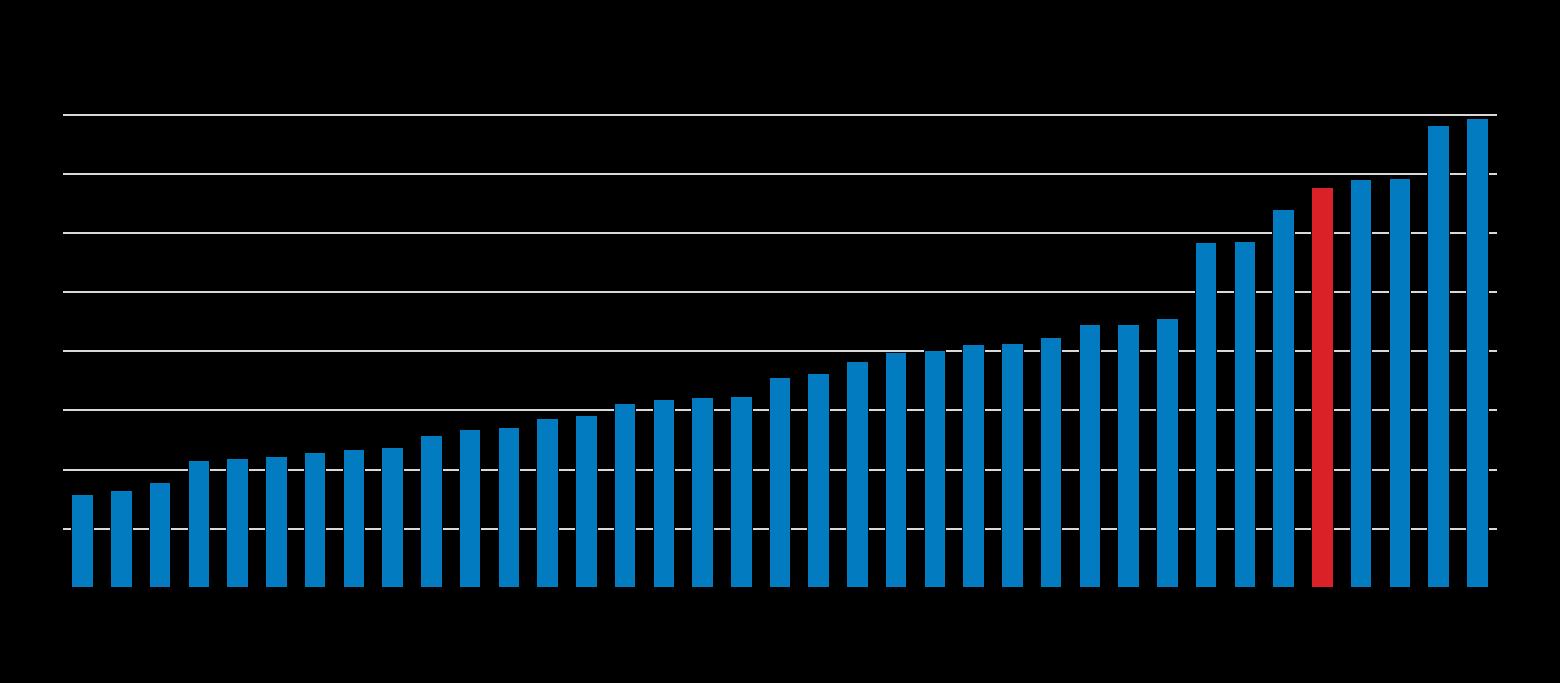










Source: OECD Economic Outlook: Statistics and Projections database; and OECD calculations.





Source: Israel Central Bureau of Statistics: and OECD calculations.

Source: OECD Price Statistics database.



Source: OECD Economic Outlook Statistics and Projections database, OECD Annual National Accounts Database.




Note: In the "Halt in labour market integration" scenario, the labour force participation rates of Haredi, Arab-Israeli and non-Haredi women remain at their current level. Based on Argov and Tsur (2019) and MoF (2019), this scenario implies that the employment rate will be around 4 percentage points lower compared to the baseline in 2060, potential growth 0.2 percentage points per year lower and the primary deficit on average 0.9 percentage points higher. The “Labour, educational and competition reforms and infrastructure investment” scenario is based on the OECD Long-Term growth Model and reform scenario outlined in the Survey.
Source: OECD Long-term Economic Model.

• Maintain a tight of monetary policy stance to bring inflation back to the target range.
• Maintain a neutral fiscal policy stance and ensure that fiscal support to vulnerable households and firms affected by higher costs is targeted and temporary


• Formulate a medium-term fiscal strategy to ensure fiscal sustainability while encouraging adequate spending on infrastructure, education and labour market programmes
• Gradually increase the retirement age of women to that of men. Thereafter link the future statutory retirement age to changes in life expectancy





Note: Data refer to 2022.
Source: Israel Central Bureau of Statistics.



Note: Data refer to 2019.
Source: Israel Central Bureau of Statistics.


Note: Workers with income below the poverty line after taxes and transfers, living in households with a working-age head and at least one worker. 2019 for Israel, 2021 for CRI and USA.

Source: OECD Income Distribution database.

Note: Hebrew speakers are “non-Haredi Jews”.

Source: OECD (2019), PISA 2018 Results (Volume I): What Students Know and Can Do, PISA, OECD Publishing, Paris, https://doi.org/10.1787/5f07c754-en.


Note: VET refers to Vocational Education and Training. OECD is an unweighted average of the countries shown.
Source: OECD (2020), OECD Employment Outlook 2020: Worker Security and the COVID-19 Crisis, OECD Publishing, Paris, https://doi.org/10.1787/1686c758-en.




Note: Data for ISR are from the Ministry of Finance and have been computed as the average between Q1-2019 and Q1-2020. Labour market transitions for European countries are computed as the number of working-age individuals moving between two statuses from one year to another as a share of average employment between these two years. Job-to-Job transitions measure job changes from one job to another. Data refer to 2019 with the exception of NOR (2018).

Source: OECD calculations based on Ministry of Finance of Israel; and Causa, O., N. Luu and M. Abendschein (2021), "Labour market transitions across OECD countries: Stylised facts", OECD Economics Department Working Papers, No. 1692, OECD Publishing, Paris, https://doi.org/10.1787/62c85872-en.


Note: High-tech companies are defined as those companies appearing in the Start-Up Nation Central (SNC) Finder database. A company must meet all the following criteria: (1) It develops a proprietary technology/invention, (2) it has an office in Israel with local R&D activity, (3) at least one of the founders must be Israeli. Covered high-tech sectors include Industrial Technologies, Fintech and eCommerce, Enterprise Solutions, Security and Safety Technologies, Life Science Technologies, and Software Applications .

Source: State Comptroller and Ombudsman of Israel (2021), "Workforce 2030”.

• Remove government subsidies for yeshiva students and condition childcare support on fathers’ employment in addition to mothers’ employment.
• Permanently re-introduce the bonus for second earners in the Earned Income Tax Credit and align fathers’ benefits with those of mothers.
• Increase the provision of accredited child-care in Arab municipalities.
• Introduce paid paternity leave.
• Increase funding for Arab schools to equalise their budget to schools with similar socio-economic profiles in the Hebrew sector.
• Create a National Qualifications Framework and improve pathways for mobility between upper-secondary schooling, post-secondary VET, and tertiary degrees.

• Implement a comprehensive strategy to broaden the high-tech talent pool, including foundational skills in middle school, post-graduate degrees and short-cycle technical certificates, coding bootcamps, internships and mentoring activities.




Source: OECD Health Statistics database.





Source: OECD Health Statistics database.

Source: OECD Regional Statistics database.




• Increase the student intake in medical schools.

• Strengthen incentives for newly-trained doctors to work in the periphery
• Regulate prices in private health care and establish a compensation mechanism for services provided by the public sector to the private health care sector.





Note: Productivity is measured as value added per employee and weighted by sectoral employment shares. Data is for 2018 and is limited to agriculture, forestry, fishing, mining, quarrying, manufacturing, electricity, gas, water, waste, construction and market services (i.e. categories from A to N according to the ISIC Rev.4 classification).
Source: Bank of Israel; Israel Central Bureau of Statistics; and OECD calculations.



Note: Digital Intensity Index (DII) is a composite indicator based on an enterprise’s use of 12 selected digital technologies. The DII distinguishes four levels of digital intensity for each enterprise: 0 to 3 points entails a very low level of digital intensity, 4 to 6 – low, 7 to 9 – high and 10 to 12 points – very high.
Source: G. Be’ery and I. Esperanza (2021), “The digital gap of the business sector in Israel”, Ministry of Economics and Industry.

Note: The Product Market Regulation (PMR) indicator is a composite index that encompasses a set of indicators that measure the degree to which policies promote or inhibit competition in areas of the product market where competition is viable. Scores range from 0 to 6 and increase with restrictiveness (data refer to 2018).


Source: OECD Product Market Regulation database.

Note: Core infrastructure includes transport infrastructure (roads, rail, ports, airports), water&sanitation, power&electricity, and telecommunication. Data refer to 2015.

Source: Office of the Accountant General, Ministry of Finance, ITF; GWI; IHS Global Insight; McKinsey Global Institute analysis; Israel Rail; Israel Airport Authority.


• Closely monitor the deployment of fibre broadband connections in underserved areas and align subsidies with actual deployment costs if needed.
• Evaluate existing grants for technology adoption and digital training and expand effective programmes targeted towards SMEs in traditional sectors.
• Further cut tariffs and non-tariff barriers, and streamline trade regulations.





Source: OECD Environment database; OECD Population database; International Energy Agency (IEA) database; Israel's nationally determined contribution (NDC) 2021; and OECD calculations.



Source: OECD Environment database; OECD Population database; International Energy Agency (IEA) database; Israel's nationally determined contribution (NDC) 2021; and OECD calculations.




• In the medium-term, gradually increase excise taxes on non-transport fuels to levels that reflect environmental costs and introduce consistent carbon pricing across all sectors.
• Partially use environmental tax revenues to mitigate distributional impacts, enhance energy efficiency and improve public transportation.
• Streamline permit procedures and increase public land available for utility-scale solar installations while further strengthening incentives for distributed solar installations.

https://oe.cd/Israel


Disclaimers:
The statistical data for Israel are supplied by and under the responsibility of the relevant Israeli authorities. The use of such data by the OECD is without prejudice to the status of the Golan Heights, East Jerusalem and Israeli settlements in the West Bank under the terms of international law. This document and any map included herein are without prejudice to the status of or sovereignty over any territory, to the delimitation of international frontiers and boundaries and to the name of any territory, city or area.

